When the pandemic is over, Marianne Bergli would like to show you something: The Northern Lights. Marianne's team at Heaven on Earth Aurora Tours is eager to see you when flights to Norway resume--perfect for small groups/families. | | |
EMERGING SUNSPOT ALERT: A sunspot is emerging in the sun's southern hemisphere, right here. The spot's magnetic polarity and high latitude mark it as a member of new Solar Cycle 25. The tiny spot will have to grow and survive the day, however, in order to receive an official number. Aurora alerts: SMS text.
THE RAPID BRIGHTENING OF COMET NEOWISE: Comet NEOWISE (C/2020 F3) is passing by the sun this week–and it’s looking good. The comet just experienced a sharp increase in brightness recorded by coronagraphs onboard the Solar and Heliospheric Observatory (SOHO). Click to play a 4-day movie of the surge:
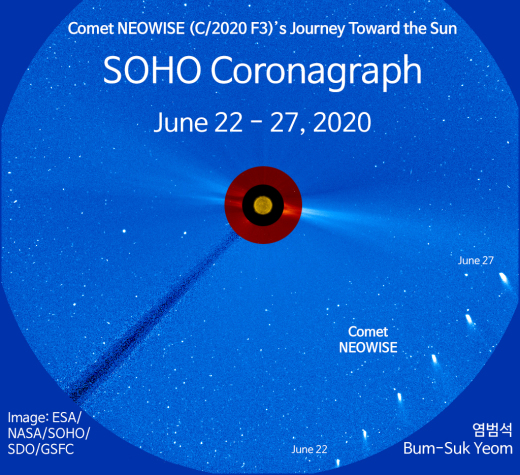
"During the transit, Comet NEOWISE increased in brightness from magnitude +4 to +1.8–an almost 8-fold jump," says planetary scientist Qicheng Zhang of Caltech, who analyzed the images. "If the comet maintains this brightness, it will be visible to the naked eye when it emerges from the sun’s glare in July."
Zhang is a bit concerned, however, that the rapid brightening might be too much of a good thing. "When a comet brightens this quickly (2.2 magnitudes in only ~4 days) it could be a sign that the nucleus is unstable. Comet NEOWISE might yet disintegrate," he cautions.
It wouldn't be the first time. Earlier this year two comets, ATLAS (C/2019 Y4) and SWAN (C/2020 F8), approached the sun with much fanfare, then disintegrated before they could become naked-eye objects.
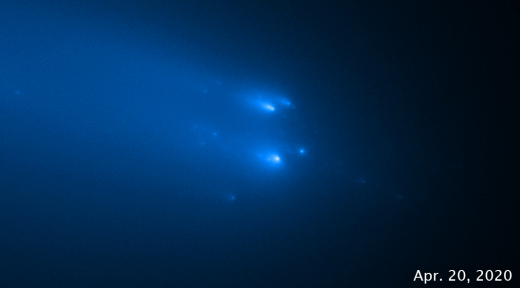
Above: The disintegration of Comet ATLAS. Credit: Hubble Space Telescope. [more]
Will Comet NEOWISE end the same way?
"I don’t think so," says Karl Battams of the Naval Research Lab in Washington DC. "Comet NEOWISE looks healthy to me. Throughout its passage across the coronagraph, the comet showed a smooth-and-steady brightness increase, perhaps a little steeper than we might like, but nothing that makes me enormously concerned for its health, as long as it has a reasonably large nucleus."
We'll soon find out. "Later this week, around perihelion (closest approach to the sun) the comet may be observable by skilled astronomers low in the morning twilight," says Zhang. "If it maintains anything close to its brightness as it left SOHO’s field of view, it will most likely be recovered from the ground by then."
Any sightings this week could be very good news, indeed. As July unfolds, the comet will swing around the sun and pop up in the evening sky–perfectly placed for casual sky watchers if anything remains to be seen. Stay tuned for updates.
Realtime Space Weather Photo Gallery
Free: Spaceweather.com Newsletter
A GIFT FOR STAR WARS FANS: A good bounty hunter will go just about anywhere. On Jun 13, 2020, the Mandalorian hitched a ride to the stratosphere onboard an Earth to Sky Calculus cosmic ray balloon. Here he is, floating 113,189 feet above the Sierra Nevada mountains of central California:
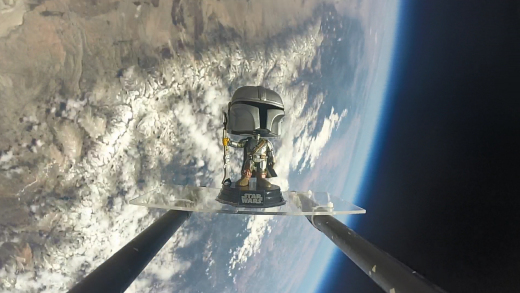
You can have him for $114.95. The students of Earth to Sky are selling Mandalorian bobbleheads to raise money for their cosmic ray ballooning program. Each figurine comes with a greeting card showing the bounty hunter in flight and telling the story of his journey to the edge of space and back again. They make great gifts for Star Wars fans.
Far Out Gifts: Earth to Sky Store
All sales support hands-on STEM education
3D NOCTILUCENT CLOUDS (UPDATED): Noctilucent clouds (NLCs) have been studied for almost 200 years, yet much about them remains unknown. Seeded by meteoroids, they float near the edge of space in a layer no more than a few kilometers thick. How are the clouds arranged inside that narrow layer? Two German photographers decided to find out. During a bright display of NLCs on June 7th, Michael Theusner and Maciej Libert photographed the same clouds from two cities 120 km apart:
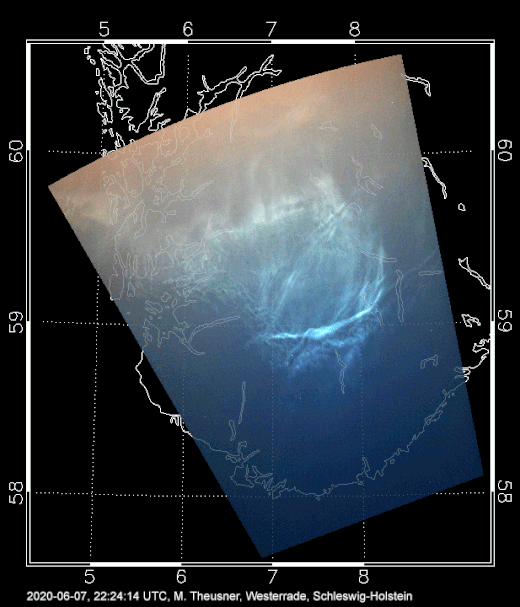
"The long baseline of 120 km allowed us to construct a real 3D image of that cloud," says Theusner. "First, we re-projected the images onto the ground. Then, we created an anaglyph from the undistorted images. Here it is. Using red/cyan glasses, you can see the true 3D structure of the cloud."
Many readers won't have 3D glasses. For them, Hanno Falk, an independent expert in 3D imaging, created a no-glasses version. Cross your eyes to merge the two images, shown below, and relax your stare into infinity to see the cloud's 3D structure.
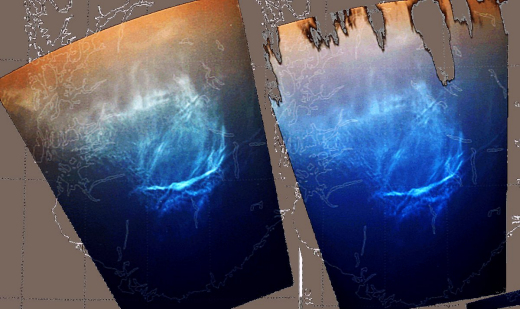
Click to expand this image!
The most striking feature of the 3D view is a fold in the cloud. In a wide arc across the bottom of the image, one layer of frosted meteor smoke is clearly floating atop another. The depth of the cloud is no more than 2 km.
"From the images and their geolocation, we deduced the average altitude of the cloud: 84 km," says Theusner. "Its lowest parts were at 83 km and its highest at 85 km--a very narrow layer, indeed."
Realtime Noctilucent Cloud Photo Gallery
Free: Spaceweather.com Newsletter
Realtime Aurora Photo Gallery
Free: Spaceweather.com Newsletter
Every night, a network of
NASA all-sky cameras scans the skies above the United States for meteoritic fireballs. Automated software maintained by NASA's Meteoroid Environment Office calculates their orbits, velocity, penetration depth in Earth's atmosphere and many other characteristics. Daily results are presented here on Spaceweather.com.
On June 30, 2020, the network reported 19 fireballs.
(19 sporadics)
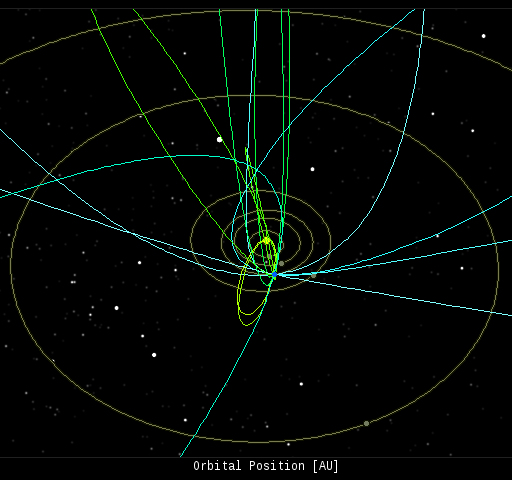
In this diagram of the inner solar system, all of the fireball orbits intersect at a single point--Earth. The orbits are color-coded by velocity, from slow (red) to fast (blue). [Larger image] [movies]
Potentially Hazardous Asteroids (
PHAs) are space rocks larger than approximately 100m that can come closer to Earth than 0.05 AU. None of the known PHAs is on a collision course with our planet, although astronomers are finding
new ones all the time.
On June 30, 2020 there were 2037 potentially hazardous asteroids.
 |
Recent & Upcoming Earth-asteroid encounters: | Asteroid | Date(UT) | Miss Distance | Velocity (km/s) | Diameter (m) |
| 2020 MP1 | 2020-Jun-25 | 1.2 LD | 7.8 | 21 |
| 2017 FW128 | 2020-Jun-25 | 6.9 LD | 5.4 | 11 |
| 2020 MA | 2020-Jun-25 | 5.3 LD | 7.8 | 31 |
| 2020 MK | 2020-Jun-27 | 12 LD | 17.8 | 112 |
| 2020 MF1 | 2020-Jun-27 | 1.3 LD | 10.5 | 10 |
| 2020 KQ7 | 2020-Jun-27 | 10.3 LD | 2.6 | 18 |
| 2020 ME1 | 2020-Jun-28 | 2 LD | 10.9 | 20 |
| 2020 JX1 | 2020-Jun-29 | 3.3 LD | 5 | 62 |
| 2019 AC3 | 2020-Jul-01 | 10.5 LD | 3.4 | 12 |
| 2020 MK3 | 2020-Jul-01 | 1.9 LD | 8.4 | 24 |
| 2020 MT2 | 2020-Jul-03 | 16.1 LD | 8.4 | 60 |
| 2020 MO | 2020-Jul-03 | 9.3 LD | 9.6 | 41 |
| 2007 UN12 | 2020-Jul-04 | 16.7 LD | 2.9 | 6 |
| 2020 LS | 2020-Jul-04 | 19.5 LD | 11.6 | 75 |
| 2020 MU1 | 2020-Jul-11 | 18.8 LD | 2.7 | 37 |
| 2020 ML | 2020-Jul-12 | 11.4 LD | 4.4 | 23 |
| 2020 KJ7 | 2020-Jul-13 | 11.9 LD | 3.4 | 30 |
| 2009 OS5 | 2020-Jul-13 | 17.6 LD | 2.6 | 45 |
| 2020 MQ2 | 2020-Jul-14 | 17.1 LD | 8.3 | 44 |
| 2020 MX | 2020-Jul-17 | 15 LD | 5.3 | 51 |
| 2016 DY30 | 2020-Jul-19 | 9 LD | 15.1 | 3 |
| 2020 ME3 | 2020-Jul-19 | 14.8 LD | 4.6 | 24 |
| 2002 BF25 | 2020-Jul-21 | 9.4 LD | 6.8 | 129 |
| 2018 PY7 | 2020-Jul-31 | 8.9 LD | 9.5 | 16 |
| 2007 RF1 | 2020-Jul-31 | 10.7 LD | 5 | 21 |
| 2018 BD | 2020-Aug-03 | 7.6 LD | 9.4 | 3 |
| 2009 PQ1 | 2020-Aug-05 | 10.8 LD | 13.5 | 112 |
| 2020 FA1 | 2020-Aug-23 | 18.4 LD | 1.9 | 20 |
| 2016 AH164 | 2020-Aug-26 | 15.7 LD | 5.6 | 4 |
Notes: LD means "Lunar Distance." 1 LD = 384,401 km, the distance between Earth and the Moon. 1 LD also equals 0.00256 AU. MAG is the visual magnitude of the asteroid on the date of closest approach. | | Cosmic Rays in the Atmosphere |
SOMETHING NEW! We have developed a new predictive model of aviation radiation. It's called E-RAD--short for Empirical RADiation model. We are constantly flying radiation sensors onboard airplanes over the US and and around the world, so far collecting more than 22,000 gps-tagged radiation measurements. Using this unique dataset, we can predict the dosage on any flight over the USA with an error no worse than 15%.
E-RAD lets us do something new: Every day we monitor approximately 1400 flights criss-crossing the 10 busiest routes in the continental USA. Typically, this includes more than 80,000 passengers per day. E-RAD calculates the radiation exposure for every single flight.
The Hot Flights Table is a daily summary of these calculations. It shows the 5 charter flights with the highest dose rates; the 5 commercial flights with the highest dose rates; 5 commercial flights with near-average dose rates; and the 5 commercial flights with the lowest dose rates. Passengers typically experience dose rates that are 20 to 70 times higher than natural radiation at sea level.
To measure radiation on airplanes, we use the same sensors we fly to the stratosphere onboard Earth to Sky Calculus cosmic ray balloons: neutron bubble chambers and X-ray/gamma-ray Geiger tubes sensitive to energies between 10 keV and 20 MeV. These energies span the range of medical X-ray machines and airport security scanners.
Column definitions: (1) The flight number; (2) The maximum dose rate during the flight, expressed in units of natural radiation at sea level; (3) The maximum altitude of the plane in feet above sea level; (4) Departure city; (5) Arrival city; (6) Duration of the flight.
SPACE WEATHER BALLOON DATA: Approximately once a week, Spaceweather.com and the students of Earth to Sky Calculus fly space weather balloons to the stratosphere over California. These balloons are equipped with radiation sensors that detect cosmic rays, a surprisingly "down to Earth" form of space weather. Cosmic rays can seed clouds, trigger lightning, and penetrate commercial airplanes. Furthermore, there are studies ( #1, #2, #3, #4) linking cosmic rays with cardiac arrhythmias and sudden cardiac death in the general population. Our latest measurements show that cosmic rays are intensifying, with an increase of more than 18% since 2015:

The data points in the graph above correspond to the peak of the Regener-Pfotzer maximum, which lies about 67,000 feet above central California. When cosmic rays crash into Earth's atmosphere, they produce a spray of secondary particles that is most intense at the entrance to the stratosphere. Physicists Eric Reneger and Georg Pfotzer discovered the maximum using balloons in the 1930s and it is what we are measuring today.
En route to the stratosphere, our sensors also pass through aviation altitudes:

In this plot, dose rates are expessed as multiples of sea level. For instance, we see that boarding a plane that flies at 25,000 feet exposes passengers to dose rates ~10x higher than sea level. At 40,000 feet, the multiplier is closer to 50x.
The radiation sensors onboard our helium balloons detect X-rays and gamma-rays in the energy range 10 keV to 20 MeV. These energies span the range of medical X-ray machines and airport security scanners.
Why are cosmic rays intensifying? The main reason is the sun. Solar storm clouds such as coronal mass ejections (CMEs) sweep aside cosmic rays when they pass by Earth. During Solar Maximum, CMEs are abundant and cosmic rays are held at bay. Now, however, the solar cycle is swinging toward Solar Minimum, allowing cosmic rays to return. Another reason could be the weakening of Earth's magnetic field, which helps protect us from deep-space radiation.
| | The official U.S. government space weather bureau |
| | The first place to look for information about sundogs, pillars, rainbows and related phenomena. |
| | Researchers call it a "Hubble for the sun." SDO is the most advanced solar observatory ever. |
| | 3D views of the sun from NASA's Solar and Terrestrial Relations Observatory |
| | Realtime and archival images of the Sun from SOHO. |
| | from the NOAA Space Environment Center |
| | fun to read, but should be taken with a grain of salt! Forecasts looking ahead more than a few days are often wrong. |
| | from the NOAA Space Environment Center |
| | the underlying science of space weather |
 | To find reviews of new online casino sites in the UK try The Casino DB where there are hundreds of online casino reviews complete with bonuses and ratings. Get a bonus when playing at a new casino in the UK. The Genie got you covered! Looking for a new online casino? Try Casimpo the new site dedicated to making online casino simple and easy for all. |
| | These links help Spaceweather.com stay online. Thank you to our supporters! |
| | | | | | |

